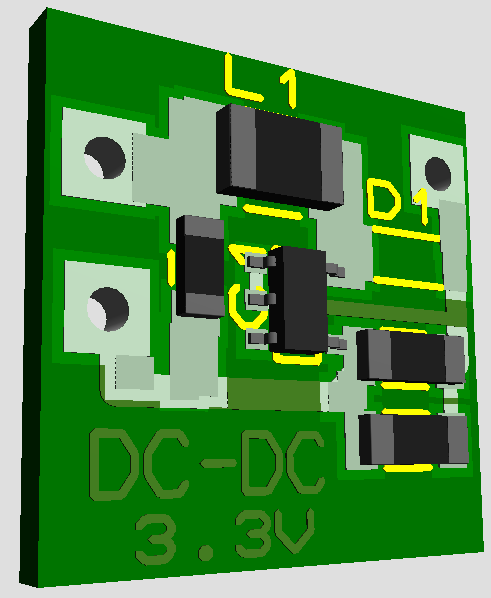Improving the power scheme of the wireless keyboard
My friend had a problem with the wireless keyboard - the batteries quickly got into it.
Moreover, when they sat down, she could still work for a long time, but the "range" sharply decreased to complete non-recoverability. And the other day I just decided to try a great microcircuit - NCP1402. He showed a friend her capabilities, and he got the idea to use it to solve problems with keyboard power.

For details - please under the cat.
The microcircuit is a step-up DC-DC converter, highly efficient and requiring a minimum of “weight”. At the input you need to apply a voltage of 0.8 volts. At the same time, the manufacturer states that, starting, the converter will work until the battery drops to 0.3 volt, if it is not turned off. It is released in versions:
NCP1402SN19T1 (1.9 V output)
NCP1402SN27T1 (2.7 V)
NCP1402SN30T1 (3.0 V)
NCP1402SN33T1 (3.3 V)
NCP1402SN50T1 (5.0 V)
')
I purchased 10 pieces of NCP1402SN33T1 for a sample at a price of about 10 rubles / piece + kit (rubles for 30).
Obviously, the problem with the keyboard was the voltage drop of the batteries, which was not enough to maintain the same keyboard range. It was decided to upgrade the power scheme. Kit includes includes:
There is a nuance with the PCB layout - for maximum efficiency, it is better to make the shortest possible tracks. But even without that, we wanted compactness - we decided to shove the board into the space in the keyboard reserved for storing the usb receiver.
Wiring was done in Proteus ARES.
I post pdf for LUT : dl.dropbox.com/u/36371114/ncp1402layout.pdf
Corroded the board, cut, made the installation of components using lukey702 and hands :)
The size of the board was 12x14mm.

We test - we connect 1 or 2 AAA batteries - at the exit - the cherished 3.3 volts.
We put in the keyboard:

We rejoice at the excellent range even on 1 battery.
PS put one AAA battery, has been working for a week, without shutting down. The voltage did not fall, the current without pressing the keys - 89µA.
Moreover, when they sat down, she could still work for a long time, but the "range" sharply decreased to complete non-recoverability. And the other day I just decided to try a great microcircuit - NCP1402. He showed a friend her capabilities, and he got the idea to use it to solve problems with keyboard power.

For details - please under the cat.
The microcircuit is a step-up DC-DC converter, highly efficient and requiring a minimum of “weight”. At the input you need to apply a voltage of 0.8 volts. At the same time, the manufacturer states that, starting, the converter will work until the battery drops to 0.3 volt, if it is not turned off. It is released in versions:
NCP1402SN19T1 (1.9 V output)
NCP1402SN27T1 (2.7 V)
NCP1402SN30T1 (3.0 V)
NCP1402SN33T1 (3.3 V)
NCP1402SN50T1 (5.0 V)
')
I purchased 10 pieces of NCP1402SN33T1 for a sample at a price of about 10 rubles / piece + kit (rubles for 30).
Obviously, the problem with the keyboard was the voltage drop of the batteries, which was not enough to maintain the same keyboard range. It was decided to upgrade the power scheme. Kit includes includes:
- Schottky diode, the most important component in terms of characteristics, for the efficient operation of the converter. The datasheet lists the requirements. I used MBR0520LT1G in the SOD123 package
- inductance coil at 47uH. I used LQH32MN470K23L, SMD1210
- 10uF input capacitor, ceramic, SMD0805
- 2 output capacitors on 22uF, ceramics, SMD1206
There is a nuance with the PCB layout - for maximum efficiency, it is better to make the shortest possible tracks. But even without that, we wanted compactness - we decided to shove the board into the space in the keyboard reserved for storing the usb receiver.
Wiring was done in Proteus ARES.
I post pdf for LUT : dl.dropbox.com/u/36371114/ncp1402layout.pdf
Corroded the board, cut, made the installation of components using lukey702 and hands :)
The size of the board was 12x14mm.

We test - we connect 1 or 2 AAA batteries - at the exit - the cherished 3.3 volts.
We put in the keyboard:

We rejoice at the excellent range even on 1 battery.
PS put one AAA battery, has been working for a week, without shutting down. The voltage did not fall, the current without pressing the keys - 89µA.
Source: https://habr.com/ru/post/170331/
All Articles